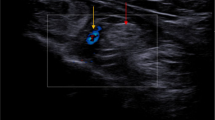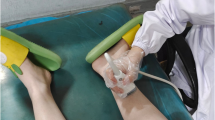Abstract
Objectives
To evaluate the stiffness of the tibial nerve with two-dimensional shear wave elastography (2D-SWE) and to determine whether 2D-SWE can be used to diagnose diabetic peripheral neuropathy (DPN).
Methods
The study included 70 consecutive diabetic patients with DPN or without DPN and 20 healthy volunteers. The tibial nerve stiffness measured with 2D-SWE was studied. The differences in stiffness values among patients with DPN, patients with clinically defined DPN, patients without DPN, and healthy volunteers based on clinical features and electrodiagnostic tests were evaluated with the Mann–Whitney U test and the Kruskal–Wallis test. Inter- and intraobserver variability was evaluated, and a receiver operator characteristic curve analysis was performed.
Results
The tibial nerve stiffness based on mean (EMean), minimum (EMin), and maximum (EMax) shear elasticity indices was significantly higher in patients with DPN and clinically defined DPN than that in patients without DPN and control subjects (p < 0.05). The area under the curve (AUC) for the SWE measurements of EMean, EMin, and EMax was 0.846, 0.867, and 0.821, respectively. An EMin cutoff value of 45.7 kPa had a sensitivity, specificity, positive likelihood ratio, and negative likelihood ratio of 74.0%, 87.6%, 6.0, and 0.3, respectively. The inter- and intraobserver agreements were excellent for the SWE measurements.
Conclusions
Tibial nerve stiffness is significantly higher in diabetic patients with DPN and clinically defined DPN. The EMean and EMin have a good accuracy for identifying DPN. Minor degree of peripheral nerve lesions appear to might exist in patients with clinically defined DPN, not detectable by electrophysiology. 2D-SWE has a potential use for cases with clinically defined DPN and can be detected with 2D-SWE.
Key Points
• 2D-SWE elastography is a noninvasive method that can be used to evaluate precise nerve stiffness for diagnosing DPN.
• Minor degree of neurologic lesion might exist early in patients with clinically defined DPN and can be detected by 2D-SWE.
• E Min and E Mean of SWE elasticity indices have better diagnostic accuracies than E Max for identifying DPN.




Similar content being viewed by others
Abbreviations
- 2D-SWE:
-
Two-dimensional shear wave elastography
- AUC:
-
Area under the curve
- CSA:
-
Cross-sectional area
- DPN:
-
Diabetic peripheral neuropathy
- ICC:
-
Intraclass correlation coefficient
- LR(−):
-
Negative likelihood ratio
- LR(+):
-
Positive likelihood ratio
- NCS:
-
Nerve conduction study
- ROC:
-
Receiver operator characteristic
- ROI:
-
Region of interest
References
Perkins BA, Bril V (2003) Diabetic neuropathy: a review emphasizing diagnostic methods. Clin Neurophysiol 114:1167–1175
Callaghan BC, Cheng HT, Stables CL, Smith AL, Feldman EL (2012) Diabetic neuropathy: clinical manifestations and current treatments. Lancet Neurol 11:521–534
Kakrani AL, Gokhale VS, Vohra KV, Chaudhary N (2014) Clinical and nerve conduction study correlation in patients of diabetic neuropathy. J Assoc Physicians India 62:24–27
Dyck PJ, Overland CJ, Low PA et al (2010) Signs and symptoms versus nerve conduction studies to diagnose diabetic sensorimotor polyneuropathy: Cl vs. NPhys trial. Muscle Nerve 42:157–164
Watanabe T, Ito H, Sekine A et al (2010) Sonographic evaluation of the peripheral nerve in diabetic patients: the relationship between nerve conduction studies, echo intensity, and cross-sectional area. J Ultrasound Med 29:697–708
Pastore C, Izura V, Geijo-Barrientos E, Dominguez JR (1999) A comparison of electrophysiological tests for the early diagnosis of diabetic neuropathy. Muscle Nerve 22:1667–1673
Miyamoto H, Halpern EJ, Kastlunger M et al (2014) Carpal tunnel syndrome: diagnosis by means of median nerve elasticity--improved diagnostic accuracy of US with sonoelastography. Radiology 270:481–486
Kantarci F, Ustabasioglu FE, Delil S et al (2014) Median nerve stiffness measurement by shear wave elastography: a potential sonographic method in the diagnosis of carpal tunnel syndrome. Eur Radiol 24:434–440
Breiner A, Qrimli M, Ebadi H et al (2017) Peripheral nerve high-resolution ultrasound in diabetes. Muscle Nerve 55:171–178
Singh K, Gupta K, Kaur S (2017) High resolution ultrasonography of the tibial nerve in diabetic peripheral neuropathy. J Ultrason 17:246–252
Riazi S, Bril V, Perkins BA et al (2012) Can ultrasound of the tibial nerve detect diabetic peripheral neuropathy? A cross-sectional study. Diabetes Care 35:2575–2579
Watanabe T, Ito H, Morita A et al (2009) Sonographic evaluation of the median nerve in diabetic patients: comparison with nerve conduction studies. J Ultrasound Med 28:727–734
Zhang C, Li M, Jiang J et al (2017) Diagnostic value of virtual touch tissue imaging quantification for evaluating median nerve stiffness in carpal tunnel syndrome. J Ultrasound Med 36:1783–1791
Ogur T, Yakut ZI, Teber MA et al (2015) Ultrasound elastographic evaluation of the median nerve in pregnant women with carpal tunnel syndrome. Eur Rev Med Pharmacol Sci 19:23–30
Paluch Ł, Noszczyk B, Nitek Ż, Walecki J, Osiak K, Pietruski P (2018) Shear-wave elastography: a new potential method to diagnose ulnar neuropathy at the elbow. Eur Radiol. https://doi.org/10.1007/s00330-018-5517-9
Dikici AS, Ustabasioglu FE, Delil S et al (2017) Evaluation of the tibial nerve with shear-wave elastography: a potential sonographic method for the diagnosis of diabetic peripheral neuropathy. Radiology 282:494–501
England JD, Gronseth GS, Franklin G et al (2005) Distal symmetric polyneuropathy: a definition for clinical research: report of the American Academy of Neurology, the American Association of Electrodiagnostic Medicine, and the American Academy of Physical Medicine and Rehabilitation. Neurology 64:199–207
Olaleye D, Perkins BA, Bril V (2001) Evaluation of three screening tests and a risk assessment model for diagnosing peripheral neuropathy in the diabetes clinic. Diabetes Res Clin Pract 54:115–128
Rith-Najarian SJ, Stolusky T, Gohdes DM (1992) Identifying diabetic patients at high risk for lower-extremity amputation in a primary health care setting. A prospective evaluation of simple screening criteria. Diabetes Care 15:1386–1389
Hobson-Webb LD, Massey JM, Juel VC (2013) Nerve ultrasound in diabetic polyneuropathy: correlation with clinical characteristics and electrodiagnostic testing. Muscle Nerve 47:379–384
Wu C, Wang G, Zhao Y et al (2017) Assessment of tibial and common peroneal nerves in diabetic peripheral neuropathy by diffusion tensor imaging: a case control study. Eur Radiol 27:3523–3531
Wang D, Wang C, Duan X et al (2018) MR T2 value of the tibial nerve can be used as a potential non-invasive and quantitative biomarker for the diagnosis of diabetic peripheral neuropathy. Eur Radiol 28:1234–1241
Bae JS, Kim BJ (2007) Subclinical diabetic neuropathy with normal conventional electrophysiological study. J Neurol 254:53–59
Radziwill AJ, Steck AJ, Renaud S, Fuhr P (2003) Distal motor latency and residual latency as sensitive markers of anti-MAG polyneuropathy. J Neurol 250:962–966
Dyck PJ, Davies JL, Clark VM et al (2006) Modeling chronic glycemic exposure variables as correlates and predictors of microvascular complications of diabetes. Diabetes Care 29:2282–2288
El Boghdady NA, Badr GA (2012) Evaluation of oxidative stress markers and vascular risk factors in patients with diabetic peripheral neuropathy. Cell Biochem Funct 30:328–334
Tuck RR, Schmelzer JD, Low PA (1984) Endoneurial blood flow and oxygen tension in the sciatic nerves of rats with experimental diabetic neuropathy. Brain 107(Pt 3):935–950
Sumner CJ, Sheth S, Griffin JW, Cornblath DR, Polydefkis M (2003) The spectrum of neuropathy in diabetes and impaired glucose tolerance. Neurology 60:108–111
Stengel D, Bauwens K, Sehouli J, Ekkernkamp A, Porzsolt F (2003) A likelihood ratio approach to meta-analysis of diagnostic studies. J Med Screen 10:47–51
Nogueira-Barbosa MH, Lugão HB, Gregio-Júnior E et al (2017) Ultrasound elastography assessment of the median nerve in leprosy patients. Muscle Nerve 56:393–398
Funding
This study has received funding by the National Natural Science Foundation of China (no. 81471713).
Author information
Authors and Affiliations
Corresponding author
Ethics declarations
Guarantor
The scientific guarantor of this publication is Ran Haitao.
Conflict of interest
The authors declare that they have no conflict of interest.
Statistics and biometry
No complex statistical methods were necessary for this paper.
Informed consent
Written informed consent was obtained from all subjects (patients) in this study.
Ethical approval
Institutional Review Board approval was obtained.
Methodology
• Prospective
• Diagnostic or prognostic study
• Performed at one institution
Rights and permissions
About this article
Cite this article
Jiang, W., Huang, S., Teng, H. et al. Diagnostic performance of two-dimensional shear wave elastography for evaluating tibial nerve stiffness in patients with diabetic peripheral neuropathy. Eur Radiol 29, 2167–2174 (2019). https://doi.org/10.1007/s00330-018-5858-4
Received:
Revised:
Accepted:
Published:
Issue Date:
DOI: https://doi.org/10.1007/s00330-018-5858-4




